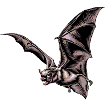Museum, University of Nebraska State

University of Nebraska State Museum: Mammalogy Papers
Document Type
Article
Date of this Version
12-23-1993
Citation
From Abstracts: Annual Meeting of the American Society of Zoologists; December 26–30, 1993. For the session "Craniofacial Adaptations of Faunivorous Mammals." Published in American Zoologist (1993) 33(5): 102A.
Abstract
Derived from insectivorous ancestors, microchiropteran bats have diversified into a remarkable array of feeding habits. Cranial and dental characteristics mirror this diversity. Insectivorous predators of hard-shelled prey have thicker jaws, well-developed cranial crests, fewer but larger teeth, longer canines and abbreviated M3s than species that take soft items. Carnivorous bats have more elongate skulls, larger brain volumes and larger pinnae, lengthened metastylar ridges, and larger protoconids compared to insectivores. Animalivorous species have large ectoloph areas compared to frugivorous and nectarivorous species, but animalivores and frugivores have large tooth areas relative to palatal area compared to nectarivores. Frugivores sacrifice ectoloph for enlarged crushing surfaces on the upper molars while nectarivores have similar proportions as animalivores but have diminutive teeth, elongated rostra, and highly thegosed upper canines. Omnivores have a more equal allocation to more kinds of teeth on the toothrow than do frugivores or animalivores.


Comments
Copyright © 1993, American Society of Zoologists. Used by permission.